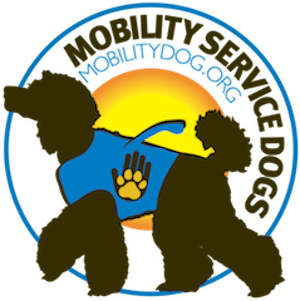Body Language Part 1: How Your Dog Reads Your Body Language
A Poodle Service Dog Looking Up at their Handler
You look at the leash, and your dog heads for the door, ready for a walk. You open the cupboard, and the dog salivates in anticipation of dinner. You put on your coat, and the dog knows you’re going out (and thinks she may get a ride in the car too).
White Poodle Searching for a Scent
When It Comes to Body Language, Dogs are Smarter than Chimps … and Toddlers
Dogs have highly developed social cognition, meaning they have a substantial innate skill at interpreting behavioral cues from the mammals they live with, both humans and other dogs.
Scientists have used a simple experimental design (one you can use too) to study this phenomenon. Start with two upside-down buckets. Out of sight of the dog, place a bit of food under one of the buckets, making sure to rub both containers with the food so the scent doesn’t give the game away. Then bring the pooch in and give a non-verbal clue indicating which bucket is hiding the food. Start by looking at that bucket, or tilting your head toward it. Then, if the dog is uncertain, ratchet up your signaling by pointing to the container concealing the treat. Last, try tapping that bucket if Princess is still unsure. Reward her with the food when she finally settles on its location.
It turns out that dogs are pretty good at this task, better even than chimps (our closest non-human cousins) and also superior to three-year-old humans. Dogs interpreted the non-verbal signals four times more accurately than the apes and twice as well as the children. Moreover, dogs exceed their wolf brethren in this interpretive ability. Experiments showed that even nine-week-old puppies still living with their mother and littermates perform better than wolves.
Built by Evolution
Social cognition comes about when it helps a species adapt to and thrive in its environment. But how did evolution produce this ability? One possibility: dogs developed and benefited from burgeoning interpretive skills early in the process of domestication. Alternatively, did the animals with the most advanced social abilities become the first and best companions, and therefore have a head start in their relationship with homo sapiens?
The scientific jury is still out on this question. It may be, for example, that social cognition was a byproduct of domestication. In the words of one scientist, ” You pick the calmer, more attentive animals, and they also happen to be the ones that are better able to pick up subtle social cues.”
White Poodle Looking at the Camera
Dogs Look at Multiple Cues
Human brains are built to specialize in faces. Certainly, we understand vocal nuances and pay attention to body language, but faces are the territory that grabs our attention. Consider how many poems and songs have been written about smiles, frowns and tears (imagine if Smokey Robinson had sung about the feet of a clown – not likely a hit). Dogs, however, are different. They do read our faces, but other bodily signals are similarly informative to them. And they pay more attention to dog faces then they do to our human mugs.
In one experiment, humans and dogs in an MRI device (at separate times, of course) were shown two-second videos of the fronts and backs of human heads and dog heads. People responded more strongly to the frontal view of a human head than to the back, and more strongly to the human head than to the dog head. Dogs did not respond to the back of a human head, and reacted more intensely to dog faces than to human ones. Notably, even the back of a dog’s head conveys information to another canine, because ear position (a key clue to a dog’s emotional state) is visible from both back and front. Humans, in contrast, can’t move our ears enough to use them for communication, from the front or behind.
Evolution has equipped our canine companions with an impressive array of communication receptors (which also include smell, hearing, taste and touch), making them skillful partners in the giving and getting of information. No wonder they are our best friends – they have so many ways of knowing and understanding us.



